X
wikiHow is a “wiki,” similar to Wikipedia, which means that many of our articles are co-written by multiple authors. To create this article, 9 people, some anonymous, worked to edit and improve it over time.
This article has been viewed 196,402 times.
Learn more...
The Federalist Papers, or The New Constitution, consists of 85 articles published in the Independent Journal and the New York Packet. Written in 1787 and 1788, these articles offered arguments in favor of the newly written Constitution of the United States. The Federalist Papers are frequently cited in works that analyze the U.S. Constitution.
Steps
Method 1
Method 1 of 4:
Using the Chicago Manual of Style
-
1Use italics to cite a specific article in text. If you are writing about a specific article in The Federalist Papers, place a citation in text right after the quote. The citation should also note the article number.[1]
- The citation would look like: Book title, article number.
- For example: The Federalist Papers, No. 51.
- You can also place the citation in a sentence, such as: “In Federalist Paper No. 51, Alexander Hamilton observed…” or “As Hamilton pointed out in Federalist Paper No. 51…”
-
2Place quotation marks around direct quotes. It’s important to note any direct quotes from The Federalist Papers in your text by using quotation marks.[2]
- So the citation would look like: As Alexander Hamilton noted at the beginning of Federalist Paper No. 78: “We proceed now to an examination of the judiciary department of the proposed government."[3]
Advertisement -
3Format citations in your footnotes. The citation should be in the following form: Author, Article name, in Book Name, ed. Name (Publisher, Publish Date), page numbers.[4]
- For example: James Madison, Federalist No.10, in The Federalist Papers, ed. Clinton Rossiter (New York: New American Library, 1961), pg 77-84.
- In your full citation in footnotes, you need to note the editor of the article. The Federalist Papers were not published as a unified work. They were gathered together over time by various editors.
- Your footnotes should begin with “1” and follow numerically. They should be superscript at the end of the quoted sentence or phrase. Using a word processing program, the footnote should automatically also appear at the bottom left of the page.[5]
-
4Cite all paraphrases and summaries in your footnotes. In the Chicago Style, you can cite any paraphrased sentences or summarized sections with a corresponding footnote. You do not need to cite the paraphrased sentence or summary in the text.
- For example, if you are paraphrasing the first line from Federalist No. 1 by Alexander Hamilton, you may write: “In Federalist No. 10, James Madison talks about deliberating the new Constitution and how important the subject is to the state of the Union.”
- Though you have simply restated the first two lines of the article, you must still cite these lines as a footnote in your text. The footnote should have a full citation: James Madison, Federalist No.10, in The Federalist Papers, ed. Clinton Rossiter (New York: New American Library, 1961), pg 77-84.
-
5Use full citations in your bibliography. You will need to cite The Federalist Papers as a source in your bibliography. If you used a specific article in your paper or document, you will need to specify this in your citation.[6]
- The citation should look like: Author, Article, in Book Name, ed. Name (Publisher, Publish Date), page numbers.
- For example: Alexander Hamilton, Federalist No. 68, in The Federalist, ed. George W. Carey and James McClellan (Indianapolis, IN: Liberty Fund, 2001), 351–52.
- If you are just using The Federalist Papers as a whole, you can cite it as one source. So the citation would look like: Carey, George, and James McClellan, eds.The Federalist. Indianapolis, IN: Liberty Fund, 2001.
Advertisement
Method 2
Method 2 of 4:
Using APA Style
-
1Use parenthesis to cite a source in text. If you are directly quoting from an article, include the author of the article, the year of publication, and the page number (preceded by “p.”) at the end of the quote.
- For example: He noted: “After an unequivocal experience of the inefficiency of the subsisting federal government, you are called upon to deliberate on a new Constitution for the United States of America.”(Hamilton, 2001, p. 23)[7]
- You would use 2001 as the date because the source you are using (Alexander Hamilton, Federalist No. 68, in The Federalist, ed. George W. Carey and James McClellan (Indianapolis, IN: Liberty Fund, 2001), 351–52.) was published in 2001.
-
2Only use footnotes or endnotes when necessary. APA style does not encourage the use of footnotes or endnotes. But if you feel you need to use notes in your text to prevent plagiarism, APA style has two types of footnotes:[8]
- Content footnotes: these notes provide supplemental, or extra, information to your readers. Be brief and try to limit the footnote to one small paragraph. You should also point readers to information that is available in more detail elsewhere.
- For example: 1 See DeWeese (2000), especially Chapters 1 and 2, for an insightful analysis of Hamilton’s article.
- Copyright permission notes: If you quote more than 500 words of published material, or think you may be in violation of “Fair Use” copyright laws, you must get formal permission from the author(s). The other sources can appear in the reference list at the end of your paper or document. Follow the same formatting rules as the content footnote. Then, attach a copy of the permission letter to the document.
- Begin the copyright permission footnote with “Note”. The format is: Note: From Article Title by Author, Journal Title, Journal Number, page number. Copyright Date by Copyright Holder. Reprinted with permission.
- For example: Note: From The Federalist Papers: A Study by D. DeWeese, 2000, American Letters, 20, p. 122. Copyright 2000 by Flag Publishing. Reprinted with permission.
- For both types of footnotes, always insert the number in superscript at the end of the sentence, after the punctuation mark. If the footnote appears in a sentence in parentheses, the footnote should appear within the parentheses.
-
3Cite all summaries and paraphrases in text. According to the APA guideline, your citation should make reference to the author and year of publication in the text. APA style also encourages you to provide the page number for the source, but this is not required.
- For example: According to Hamilton (2001), the union is crucial to the Constitution.
- The citation of a summary or paraphrase could also appear as: He argued that the union is crucial to the Constitution. (Hamilton, 2001, p. 99)
-
4Create full citations in your bibliography. Just like in Chicago Style, you will need to cite The Federalist Papers as a source in your bibliography for your paper in APA style. If you used a specific article in your paper or document, you will need to specify this in your citation.
- The citation should appear as: Author (Year of publication). Title of chapter. Editor (Eds.), Title of book (pages of chapter). Location: Publisher.
- For example: Alexander Hamilton (2001). Federalist No. 68, ed. George W. Carey and James McClellan, The Federalist (351–52). Indianapolis, IN: Liberty Fund.
- If you are just using The Federalist Papers as a whole, you can cite it as one source. So the citation would look like: Author or editor, (Year of publication). Title of work. Location: Publisher.
- For example: Carey, George, and James McClellan, eds. 2001. The Federalist. Indianapolis, IN: Liberty Fund.
Advertisement
Method 3
Method 3 of 4:
Using MLA Style
-
1Use the author-page method of in-text citation. In MLA style, the author’s last name and the page number (s) from which the quotation or paraphrase is taken must appear in the text. A complete reference should also appear in a Works Cited page. The author’s name can appear in the sentence in the text or in parentheses following the quotation. The page number should always appear in parentheses.[9]
- For example: Hamilton stated that the union was “crucial to the Constitution” (99).
- It could also appear as: In Federalist No. 51, he also stated the union was crucial. (Hamilton 99)
-
2Only use endnotes and footnotes when necessary. MLA style discourages the use of endnotes and footnotes as long explanatory notes can be distracting to readers. But if you need to use endnotes or footnotes, in MLA style, there are two types:[10]
- Bibliographic notes. These are other publications your readers can consult for extra information on a particular topic.
- For example: 1 See DeWeese (2000), especially Chapter 1 and 2, for an insightful analysis of Hamilton’s article.
- Explanatory notes, or content notes. These are brief notes of additional information that might be too long for the main text.
- For example: 1 In a 2000 interview, he stresses this point even more strongly: “Reform is essential to the union”. (DeWeese 124)
- All footnotes should appear as numbers in superscript at the end of sentences, after the punctuation mark. If the footnote appears in a sentence in parentheses, the footnote should appear within the parentheses.
-
3Create full citations in a Works Cited page. For MLA style, you will need to cite The Federalist Papers as a source in a Works Cited page at the end of your paper. If you used a specific article in your paper or document, you will need to specify this in your citation.
- The citation should appear as: Last name, First name. Title of Essay. Title of Collection. Ed. Editor's Name(s). City of Publication: Publisher, Year. Page range of entry. Medium of Publication.
- For example: Hamilton, Alexander. Federalist No. 68. The Federalist. Ed. George W. Carey and James McClellan. Indianapolis, IN: Liberty Fund, 2001. 351–52. Print.
- If you are just using The Federalist Papers as a whole, you can cite it as one source. So the citation would look like: Last name, First name. Title of Book. City of Publication: Publisher, Year of Publication. Medium of Publication.
- For example: Carey, George, and James McClellan, eds.The Federalist. Indianapolis, IN: Liberty Fund, 2001. Print.
Advertisement
Method 4
Method 4 of 4:
Federalist Papers Basics
-
1Be aware of the origin of The Federalist Papers. While The Federalist Papers were published anonymously, three of the founding fathers, Alexander Hamilton, who became Secretary of the Treasury, John Jay, who became Chief Justice of the Supreme Court, and James Madison, who served in congress before becoming the fourth president were later revealed to be the authors of the articles. The Federalist Papers are legally established as important references to the creation of the Constitution.[11]
-
2Cite all quotes, paraphrases, and summaries from The Federalist Papers. Even if you paraphrase or summarize a quote or section from the articles, you still must cite it. Failure to cite the original source of a quote or a paraphrase of the original source is considered plagiarism.[12]
- Paraphrasing and summaries are restatements in your own words of written or spoken text. A paraphrase usually restates a portion of the text in a few sentences. A summary condenses larger chunks of text. When paraphrasing and summarizing, you must reword the information completely and not just substitute a few words from the original text. You must also be careful not to change the original meaning in the original text with your rewording.
- All three citation styles require you to cite all quotes and paraphrasing in text. However, each style cites paraphrasing in different ways.
-
3Don’t overuse citations of The Federalist Papers. This may draw criticism from legal experts who think that the influence of The Federalist Papers on the Constitution are not well founded, or a professor who wants to see you use more than one source for your paper.
- Some legal experts believe The Federalist Papers are self-contradictory or that they may not have persuaded the ratifiers of the Constitution at all. They also argue that The Federalist Papers were written to support the ratification of the Constitution, rather than to explain it and that they are an unreliable source for determining the original intent of the founding fathers because of the secrecy of the Constitutional Convention.
- All of these critiques of The Federalist Papers are valid. But none of them work against the articles in a significant way. So if you are going to make a claim about the original meaning of The Federalist Papers, take the counterarguments noted above into account.
Advertisement
Community Q&A
-
QuestionWhat was the original publisher for the Federalist Papers?
 DonaganTop AnswererThey were originally published in a few (now defunct) New York City newspapers.
DonaganTop AnswererThey were originally published in a few (now defunct) New York City newspapers. -
QuestionWasn't James Madison credited for writing Federalist 51? Step 1 has Hamilton listed as the author.
 DonaganTop AnswererEither of those men could have been the author. Several of the Federalist Papers -- including #51 -- are credited to either Madison or Hamilton, as the authorship of those particular essays is not known with certainty.
DonaganTop AnswererEither of those men could have been the author. Several of the Federalist Papers -- including #51 -- are credited to either Madison or Hamilton, as the authorship of those particular essays is not known with certainty.
Advertisement
References
- ↑ https://web.ics.purdue.edu/~mclauchl/Sp09/POL%20425/MARONBK.PDF
- ↑ https://www.bibguru.com/b/how-to-cite-the-federalist-papers/
- ↑ https://www.easybib.com/guides/citation-guides/books/the-federalist-papers
- ↑ https://web.ics.purdue.edu/~mclauchl/Sp09/POL%20425/MARONBK.PDF
- ↑ https://www.bibguru.com/b/how-to-cite-the-federalist-papers/
- ↑ https://www.easybib.com/guides/citation-guides/books/the-federalist-papers
- ↑ https://www.bibguru.com/b/how-to-cite-the-federalist-papers/
- ↑ https://www.easybib.com/guides/citation-guides/books/the-federalist-papers
- ↑ https://www.bibguru.com/b/how-to-cite-the-federalist-papers/
About This Article
Advertisement
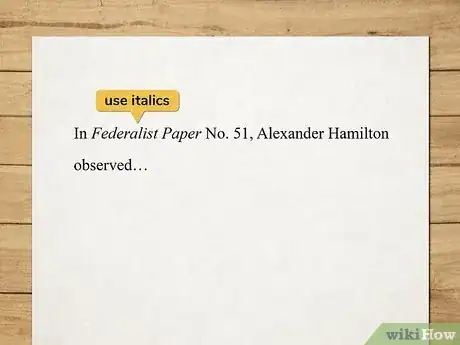
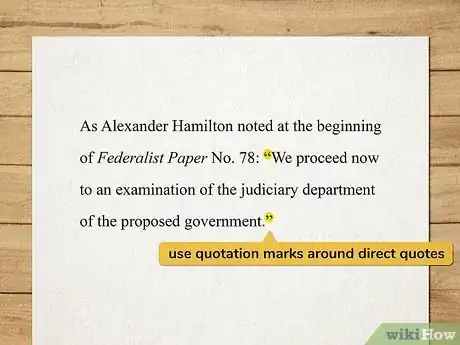
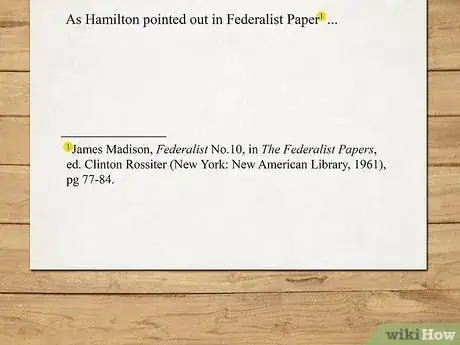


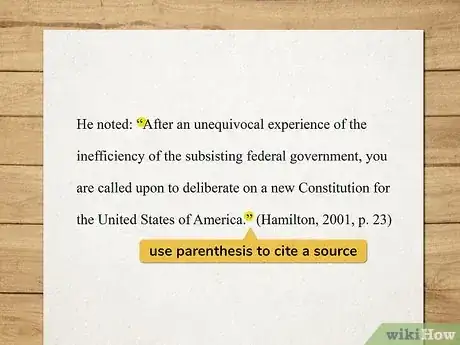

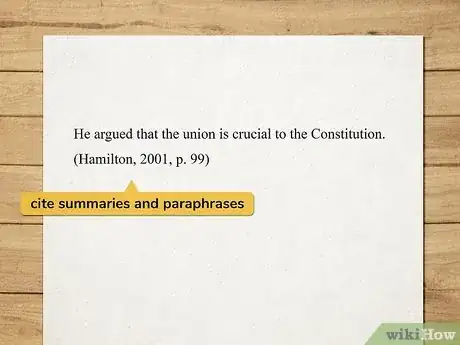
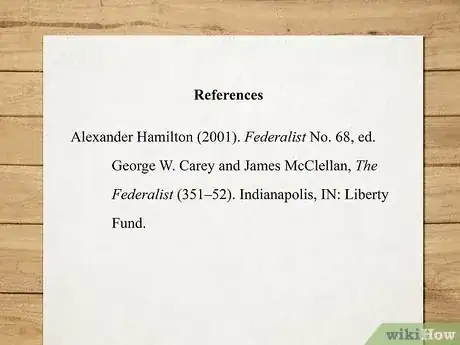
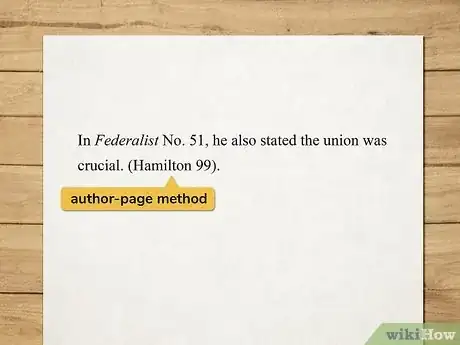
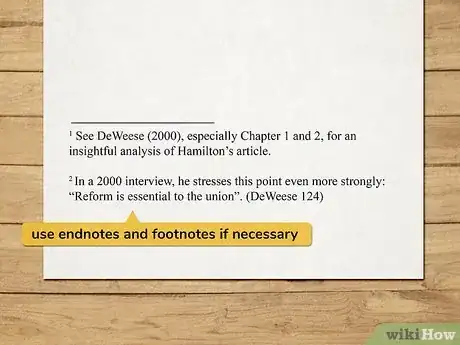
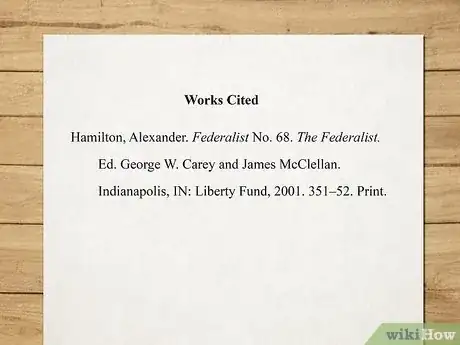

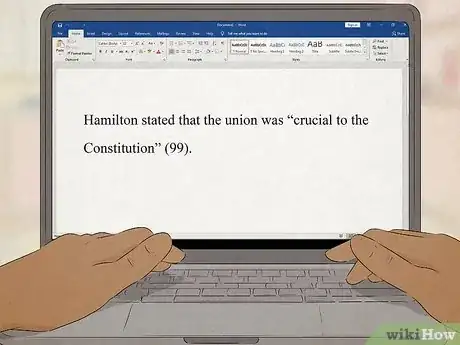





-Step-13-Version-3.webp)





-Step-13.webp)

-Step-9-Version-2.webp)













































